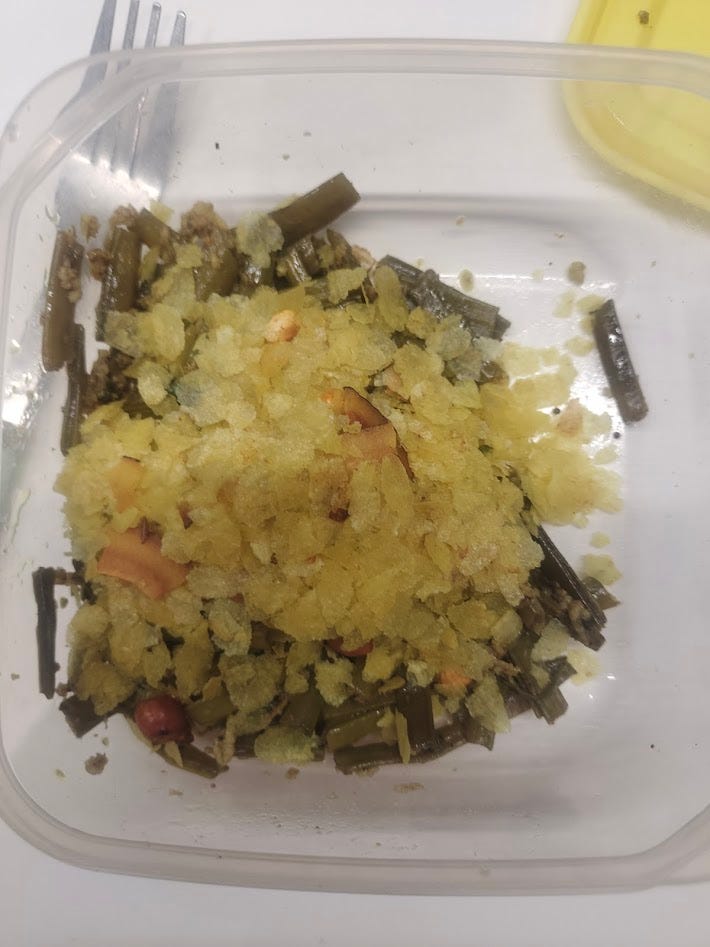Matki usal (which is a thin curry made of sprouted moth beans and goda masala) is really nothing like a missal tarri (which is a thin curry made of sprouted moth beans and kanda lasun masala).
But nonetheless, my mother-in-law sometimes takes the leftover matki usal, blitzes up a quick green chutney, lashes some date-tamarind chutney on top, covers the whole mess in chopped tomatoes, chopped raw onions, chopped cilantro, and a handful of crunchy snack mix— farsan— from a giant dabba in the closet. She calls this “missal.”
It isn’t, but what it is is an invitation.
Chaat is “a family of savory snacks that originated in India “ (that’s Wikipedia). Pani puri are chaat, as are dabeli, kachori, aloo tikki, bhel. Chaat is about a pool of marbeled sauces, the distinctive tangy-black salt taste of chaat masala, fried noodles known as sev. Like every family, chaat has its distant cousins, but ultimately, there is indeed a hard line. Grilled sandwiches, a street food available at chaat stalls: not chaat. Chaat as a noun has limits.
But chaat as a verb is up to you.
I am not really appetized these days.
Crazy, because I am surrounded by some of the most delicious food on this whole planet. Blame the heat, for one thing. And also blame the let-them-eat-cake of it all. How shitty it feels to take pleasure in food at this particular moment, in general and in specific, the way a Potraj kid comes up to my window and makes the universal gesture for money as I have plopped a huge bag of snacks from Joshi Sweets on the passenger seat, and I show my empty wallet— showing not that I am broke but that I am rich enough that I don’t carry cash— and he makes the universal gesture for hungry and so I tear open one of the packets, handing him a single besan laddoo, considering only after he takes it that I should have given the whole pack, except then I would be short on lunchbox snacks for the week, although I guess I could have always ordered more. I am sorry to type about poverty, begging. This is a tired anecdote. But really: I don’t feel hungry.
So then: chaat. Not chaat the snack, but chaat the process, the enticement. Jenny Rosenstrach calls this a “hook”— “something that casts a warm and exciting glow over the rest of the meal.” One of her key examples is roasted chickpeas, so close to the Indian fried-chickpea-flour-sev-gathiya-fafda-sphere. Another Rosenstrach “hook” is a tangy, creamy dressing, which brought to mind Pune’s SPDP, sev potato dahi puri, probably my preferred chaat from out and a love letter to yogurt sauce.
But you could also just use a mountain of literal sev. Leftover upma, reheated with the lid of the tupperware still reverse-embossed in the porridge, is transformed by a squeeze of lime and a mound of sev made from potato starch, pale and enticing. Leftover gawar bhaji, a real “eat your veggies!'“ veggie in my book, becomes chaat if you unload a few fistfuls of Chitale chiwda on top.
“Anything can be chaat” writes Diya Mukherjee in Vittles, giving patient direction for chaat provisioning and assembly in the Global North. I wondered whether I should finish writing this essay, whether I was saying the same thing but without even a recipe. But I guess I am wondering, adjacently, “can anything chaat?” Could anything become, with a jazzy sauce or a sprinkle of chaat masala or a handful of crushed up tortilla chips on top, appetizing, enticing, even fun?
I recognize this is about as hot a tip as today when I explained the concept of a QUESADILLA to some other moms at school, who seemed so genuinely interested by my suggestion that leftover methi parathas become more interesting when folded around a handful of pre-shredded cheese and fried on the tava that they asked me to make a short video of myself preparing one.
One time I shared with a buddy that I had a new habit of bringing a whole carrot to work and eating it like a horse— I was amazed by how easy this was, how delicious— and he was like, “wait, that’s it? A carrot?”
I am reminded that all these little tactics are small and stupid compared to something muscular, like a strategy.
Do snacks need to mean something? To be about something? To do something? A devil on my shoulder says “who cares?” and an angel on my shoulder says “I care about snacks! I care tremendously.” I don’t know. Today in class we were talking about the difference between queer and queered spaces, the importance of queer as a verb, as an oppositional tactic. This other paradigm— queering— suggests that digital spaces and technological tools, hostile though they may be, could be remade by and for the needs of a committed group of artists or activists. Is it too much, lowbrow, offensive, dumb, utopian, or brain-rotted to think about snacks this way? The logic of the verb: one specific dull, lifeless thing— leftovers— becomes again vital, desirable, fun. That appetites and desires are basic functions of our wills, that they matter greatly. That transformations, even small ones, remain possible. That anything could chaat. That chaat could be anything.




